
So you think you know the Peak District? Rob Ganley says take another look.
There is so many places there that you might have not realized or noticed - come on a trip with us!
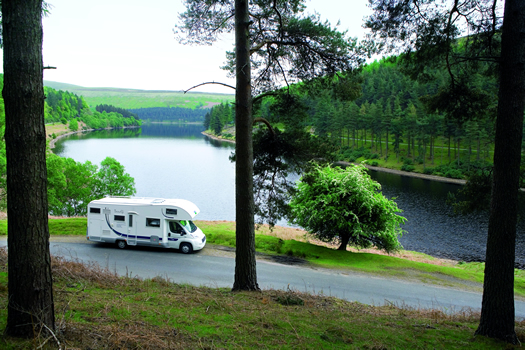
I have always found the Peak District hard to peg down. For starters, it’s a bit of a misnomer really. Just where are the pointed tops of the peaks you’d expect to find? Not only that, it maps over a handful of different counties including West and South Yorkshire, Lancashire and Staffordshire but mostly sits inside Derbyshire so I had always thought that it didn’t have its own, unique flavour but was instead a hotchpotch of outside influences. After a week there, I realised that I was wrong, as usual, and came away with not only a fresh map of the Peak District but also its peculiarities etched into my memory.
Cooper's Camp and Caravan Site is located in the centre of the …
Quiet, relaxed and family run caravan park in Edale, Derbyshire …
We are a small friendly family run campsite in the heart of the …
The Peak District is Britain’s oldest National Park, set up in 1951. If, like me, you have a problem fixing it geographically, think of it as being slap bang in the heart of the country. Then, from the south of the Park to the north you can see the larger, national shift from lowland to upland. To the north, west and east of the park are the high moors with Kinder Scout being the tallest of all at 2088ft (636m). To the south, the terrain is flatter and gentler with a smattering of dales with names that many people will recognise, such as Dove Dale and Monsal Dale. These northern and southern areas have the names Dark Peak and White Peak respectively.
I have always found the Peak District hard to peg down. For starters, it’s a bit of a misnomer really. Just where are the pointed tops of the peaks you’d expect to find? Not only that, it maps over a handful of different counties including West and South Yorkshire, Lancashire and Staffordshire but mostly sits inside Derbyshire so I had always thought that it didn’t have its own, unique flavour but was instead a hotchpotch of outside influences. After a week there, I realised that I was wrong, as usual, and came away with not only a fresh map of the Peak District but also its peculiarities etched into my memory.
Kinder Scout is the most famous landmark in the Peak District and is in many ways the spiritual home for walking. In 1932 it was the site of an outdoor martyrdom, of sorts, when between 400 and 500 ramblers trespassed there, declaring their right to roam. They had promoted the build-up to the event by distributing handbills the week before, urging people to “take action to open up the fine country at present denied to us.” As the ramblers marched they sang the socialist anthem ‘The Red Flag’. After a successful march, five ramblers were arrested on the descent, and six were later tried and jailed for riotous behaviour. The arrests caused a national outrage and four years later an MP introduced the Access to the Mountains Act, 1939. In 1949 the first Countryside and Rights of Way Act was passed. The rambling six may have lost that infamous battle, but they’d won the war, because most of our public rights today stem from what happened that day.
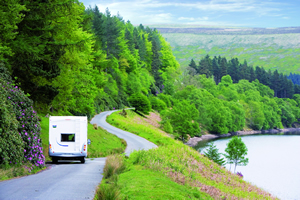 Monsal Dale is one of the most photographed areas of the Peaks
Monsal Dale is one of the most photographed areas of the PeaksWe start our ‘Snail Trail’ journey in the south. You know you’re in White Peak when you head north on the A53 from Leek and see a stark outcrop of rock rise above you, just a stone’s throw from the road. These are the beginning of The Roaches, one of the most famous and busy rock-climbing areas in the Peak District. They are a big hit with walkers, too. Stride out here on a clear day and you can see west for miles across the Cheshire Plain.
Before heading to Buxton on the A53, I decided to take a little detour east on unclassified moorland road to the tiny village of Longnor. It lies on the north bank of the River Manifold and used to be the site of a market in the late 1850s. The village clusters around the cobbled market place with its pubs and former market hall which is now a craft centre. Here, you can still see the tolls charged for selling livestock at the market. For example, it cost four pence to sell a sheep. Its modern claim to fame is that it formed the backdrop for much of the 12th and final series of the long-running TV drama ‘Peak Practice’.
Next stop, Buxton – not strictly inside the National Park boundary but you can’t leave the region without a stroll around this delightful spa town. It was the Romans who were first drawn to the place by the constant 28º thermal springs found here.
I looked in on the Pavilion Gardens, which is worth a few minutes of nosing around but no more. It’s all glass and ornate steel, with a shock of tropical and native plants inside, but beyond that it’s the usual rag-bag of restaurants and bars that you’ll find in provincial town centres.
The parish church of St John the Baptist is a more inviting building altogether. It’s a fine example of Italian-styled Georgian architecture, with some lovely mosaics behind a huge portico and beneath an elegant tower rising to a copper dome.
Past the Devonshire Royal Hospital and The Palace Hotel, it’s a short walk down the Quadrant to Spring Gardens, which is more or less the town centre, opposite The Slopes which were laid out to provide graded paths for exercise. The ornate ironwork colonnade at the junction of Spring Gardens and Bridge Street is worth stopping to admire. Then you’re at the elegant Crescent, the jewel in Buxton’s crown. It was built in the 1780s and was modelled on John Wood’s Royal Crescent in Bath. The thermal baths here were converted into a shopping arcade but a plunge pool shows how people used to take to the thermal waters.
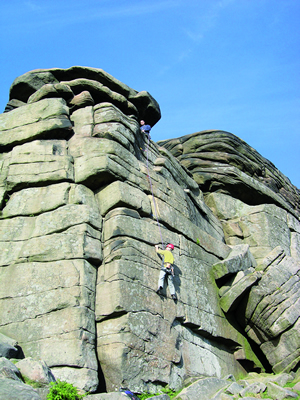 One distinctive feature of the Peak District is dry-stone walling. The limestone constructions mark field boundaries: from a high viewpoint you can see the criss-cross landscape, resembling a patchwork quilt.
One distinctive feature of the Peak District is dry-stone walling. The limestone constructions mark field boundaries: from a high viewpoint you can see the criss-cross landscape, resembling a patchwork quilt. Opposite the Crescent is The Pump Room, and the fountain known as St Ann’s Well is the source of the thermal spring, and one of the prime locations for the town’s well-dressing festival.
Turning up The Square, the twin-domed opera house is perhaps Buxton’s other great visual landmark after the Crescent. Built by theatrical architect Frank Matcham at the start of the 20th century, it seats nearly 1000 people in its auditorium.
Back through the gardens and it’s north again on the A6 to Chapel-en-le-Frith which calls itself ‘The Capital of the Peak’, but with no good reason as far as I could see. Continuing north, on the A624 takes us through Chinley and Chinley Head, with the railway high above. The A624 continues north in the shadow of the heather-covered, rugged Dark Peak highlands until it reaches Glossop. Compared to Bakewell and Dove Dale, the far north of the National Park get few visitors because its moorland can seem desolate and its long valleys are often flooded by reservoirs to provide water for the surrounding cities. It’s really ‘hardy walker’ country and the regular walkers here are known, unflatteringly, as ‘bog trotters’.
Glossop was a mill town during the 19th century, and Old Glossop is the name given to the original old town. It’s worth a half hour’s exploration of the Market Square and Cross – around which are clustered 17th- and 18th-century cottages made from Peak stone – but really not much more than this.
The road eastbound across the Pennines towards Sheffield is one of the highest and most exposed roads in Britain. The A57 is called Snake Pass and it’s a winding, attractive drive through the Dark Peak area. From the Snake Summit, the road swings down in a series of bends into Lady Clough, and before long winds alongside the River Alsop to the western arm of the Ladybower Reservoir. This was the last to be built in the Upper Derwent, between 1935 and ’45, and is the largest. It’s a major spot for anglers too.
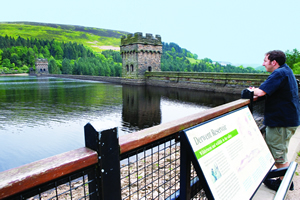 The Derwent Dam was so similar to those of the Rühr of Hitler’s Germany that the valley was used for training by 617 Squadron (’The Dambusters’) before their ‘bouncing bomb’ raid in 1943. Listen closely and you can almost hear strains of ‘The Dambusters March’
The Derwent Dam was so similar to those of the Rühr of Hitler’s Germany that the valley was used for training by 617 Squadron (’The Dambusters’) before their ‘bouncing bomb’ raid in 1943. Listen closely and you can almost hear strains of ‘The Dambusters March’As the road approaches the white-painted Ashopton Viaduct, a left turn takes you into the Derwent Valley. Despite being completely man-made, the valley is one of the marvels of the Peak District. Walkers and cyclists love to follow the route around the reservoirs, among the banked conifers.
First stop, though, is the visitor centre at Fairholmes, which tells the story of how the reservoirs came about and how the two villages of Derwent and Ashopton were sacrificed for the rising waters of the Ladybower Reservoir. Another story which has stood the test of time is that of Tip the sheepdog, who remained by the body of his owner Joseph Tagg for 15 weeks when the man died in a winter snowstorm in 1953. There’s a memorial to the dog by the western tower of the Derwent Dam. The reservoir and the dam was the proving ground for the legendary Dambusters squadron before their ‘bouncing bomb’ raid on Germany’s Rühr Valley in the 1943 Operation Chastise raids. There’s apparently a remake of the 1954 dambusters movie in the offing, with ‘Lord of the Rings’ film director Peter Jackson at the helm.
Returning down the Derwent Valley take the A6013 over the viaduct, then turn right onto the A6187 toward Castleton, but turn right for Edale before entering the village. The narrow, winding road threads through the Hope Valley before arriving at Edale. Stop at the pay-and-display car park and enjoy a stroll up the minor road to Edale village. The impressive National Park Visitor Centre, about half way up on the right, is worth a stop and a poke around, especially if you’re planning walks from here.
Edale marks the start of the 268-mile Pennine Way. The walker and journalist Tom Stephenson picked out the classic route, and since its opening in 1965 countless walkers have experienced its “baptism of mire”. At the Nag’s Head pub, plenty of tales abound of eager ramblers who couldn’t get past Kinder’s notorious peat bogs and came back to Edale with their tails between their legs.
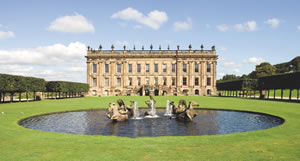 Chatsworth House is the ‘Palace of the Peak District’
Chatsworth House is the ‘Palace of the Peak District’Continuing along the road takes you down past Mam Tor, to the mouth of Winnats Pass. It’s a busy, winding road down a limestone gorge, but it’s a must-drive because it is probably the prettiest stretch of road in all the Peak District. The road leads to the Speedwell Cavern, one of four show caves in the town of Castleton.
Lead miners’ passageways, driven horizontally into the hillside, take you to the massive limestone cavern. Parts of the passageway, and the floor of the cavern, is flooded, so you have to make the journey into the cave by boat. This was once ‘legged’ through by the guides, but now it’s powered by a motor. The stalactites, stalagmites and ‘bottomless pit’ all somehow made me feel a bit scared. And this meant that I opted out of visiting the Peak, Treak Cliff, or Blue John caverns.
Even without its show caves, Castleton would rightly be one of the major honeypots of the Peak District because of Peveril Castle sitting on a limestone outcrop, gazing down on Castleton like a sentinel. It was built by William Peverel, William the Conqueror’s illegitimate son. There’s not much left of it but it’s worth the £3.50 entry fee and the effort of scaling the hill, for the views you get from the ramparts.
Heading back east on the A6187 brings you to Hathersage, best known for its connections with Robin Hood’s loyal friend Little John, and the Little John Inn just off the main road plays up to this. A turn off the road the moment you leave Hathersage, heading east, takes you up the Dale Bottom Valley where you can pick up signs for Stanage Edge, a dramatic gritstone escarpment.
This is yet more outstanding high-level climbing and walking country. But it’s great to just to sit and watch as men and women of all shapes and sizes tackle the 30m face, on all its different grades.
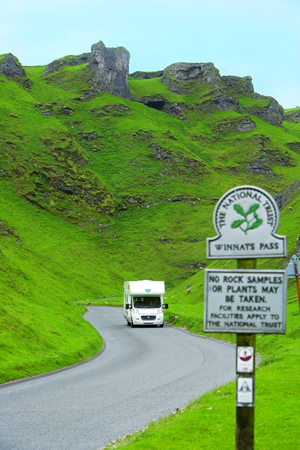 Winnats Pass is a limestone gorge which leads down towards Castleton, and it’s the most spectacular stretch of road in all the Peak District
Winnats Pass is a limestone gorge which leads down towards Castleton, and it’s the most spectacular stretch of road in all the Peak DistrictReturning to the east-bound A6187, and taking the A625 to Froggat and on to Glossop I made a surprise find – the highlight of my trip – when I stumbled across the Country Bookshop here. It’s housed in a former railway station and it is massive – bigger than many Waterstones branches you’ll find in towns. It is run by husband-and-wife team Sridhar Gowda and Geraldine Rose.
“It has been up and running for 15 years,” said Geraldine. “And we’ve been running the Peak Festival for three years.” She was talking of the literary festival which runs from April to June, and commands many of the same big-name writers who attend other, more established, literary festival events such as Hay-on-Wye or the Edinburgh Festival. Louis de Bernières, Rageh Omar and Rosie Boycott were just some of the featured guests during my short stay. At the back of the bookshop there was a dedicated reading room with dozens of chairs and a lectern for the guest reader. Also, there was a display corner which featured all the guest writers who had appeared here down the years.
Skirting around Ashford Water, Monsal Head is another ‘must’ to visit. It’s surely one of the most popular and photographed viewpoints in the Peak District.
Next stop, Bakewell. My advice is to park in the Bakewell Bridge car park by the River Wye, or at the Agricultural Centre, but it’s a much shorter walk from the former into the heart of things. Bakewell is the capital of the Peak District. The town’s greatest claim to fame is, of course, the famous Bakewell Pudding (and it’s definitely a pudding, not a tart).
The Old Original Bakewell Pudding Shop is one of three that claims to hold the original recipe – although Bloomers has a legitimate claim to this, too – for the almond and puff pastry delicacy. As legend has it, the dish was created when a flustered cook at the 17th-century Rutland Arms Hotel poured her pastry mix over the jam instead of the other way round. Today it’s a puff pastry shell with a layer of jam covered with a filling of eggs, sugar, butter and almonds.
Eat it warm! It’s worth a walk up the hill to the parish church of All Saints, which dates back to Saxon times. The south porch has Saxon-carved stones which may date back as far as AD949.
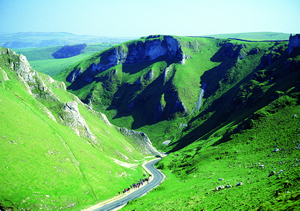 Winnats Pass is narrow, with a 1-in-5 gradient, and is supposedly haunted by the ghost of a young couple murdered by miners, but if you’re feeling brave it is worth the drive.
Winnats Pass is narrow, with a 1-in-5 gradient, and is supposedly haunted by the ghost of a young couple murdered by miners, but if you’re feeling brave it is worth the drive.Leave Bakewell by the A619 Balsow road over the bridge and within a few miles you pick up signs for Chatsworth House, home of the Dukes of Devonshire for 400 years. Of course, it’s the Palace of the Peak, a treasure trove of art and priceless historical artefacts. It’s a day’s work getting around all the rooms and the gardens, the 1000-acre park and farm shop. For a family pass for two adults and up to four children you won’t get much change out of £50, though. Entry for senior citizens, to the house and garden alone, will set you back £8.50 a head, plus £2 to park, which is rather more palatable.
The last stop on our trip is the most visited site in all the Peak District: that’s right, Dove Dale. The B5056 off the southbound A6 just south of Chatsworth takes you there on a pleasant drive through the more gently undulating southern Peak District. Pick up the signs for Dove Dale and Thorpe, along the little unclassified roads and then turn right just through Thorpe.
A seven-mile footpath runs north through the dale to Hartington, but of the million-plus visitors a year only a small percentage make it past the famous Stepping Stones, and that’s a shame because the further you wind up the valley, the better it gets. There are rock pinnacles and caves, including Tissington Spires, Pickering Tor and Reynard’s Cave to explore and admire.
On the way back, as it began to grow dusk and thankfully most of the visitors had gone on their way, I slipped off one of the Dove Dale stepping stones. I was so busy enjoying the scenery that I missed my footing and into the water went one foot and a hand. I left for home with my wet foot, a clutch of Bakewell puddings, and a clearer sense of why the Peak District is a fantastic destination.